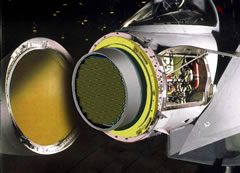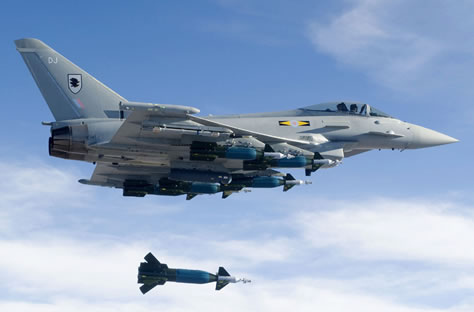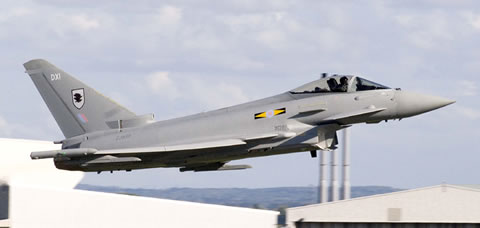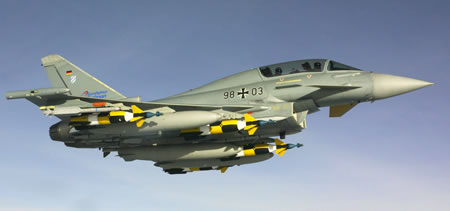Eurofighter Typhoon is an agile, highly maneuverable, twin-engine strike fighter, designed primarily for air superiority and air supremacy missions, with secondary attack capability. The aircraft’s ability to gain air superiority beyond visual range (BVR) and in close combat, and at the same time deliver high sortie rates against air, naval and ground targets in all weathers with a variety of weapons, demands close attention to pilot workload. In Eurofighter the pilot flies through use of a computerized flight control system, which offers full carefree handling.
The Saudi Typhoon order is now secured. Eurofighter GmbH has signed a contract with its shareholder BAE Systems acting as the industrial prime contractor on this government to government contract for the supply of 72 aircraft to the Kingdom of Saudi Arabia. The contract represents the second and most significant export order for the Typhoon, first was the sale of 15 fighters to Austria. Saudia received its first Typhoons in June 2009. The first 24 aircraftbeing delivered to Saudi Arabia are to be withdrawn from the Tranche 2 aircraft originally destined for the RAF.
Including the recent order, the Typhoon order book now totals 707 Eurofighter aircraft. The four Partner nations ordered 620 aircrat: 180 for Germany, 121 for Italy, 87 for Spain and 232 for the United Kingdom. Austria placed an order of 15 aircraft, the first two were delivered in July 2007. To date, 137 Series Production Aircraft, including six Instrumented Production Aircraft operated by industry, have been delivered to the customer Nations: 48 Royal Air Force, 37 German Air Force, 26 Italian Air Force, 18 Spanish Air Force and 2 to Austria. Thirty Tranche 2 aircraft are already in final assembly. Avionics and engine testing has already started for Type Acceptance of Block 8, to be achieved in Spring 2008, with deliveries scheduled to begin in Summer next year.
Air to Ground Role
With the evolving role of aerial attack in modern combat, Typhoon’s strike capability is also being enhanced, with inclusion of relevant weapon systems, sensors, targeting and communications packages as part of the baseline aircraft. An important Typhoon feature is its capability to operate from hastily prepared bases and small runways for worldwide operations. The aircraft is equipped with an advanced multi-mode radar and an extensive range of sensors and electronic countermeasures.
By the end of June 2008, 135 Eurofighter Typhoon have been delivered to seven units in four nations. The nations’ fleets have accumulated over 40,000 flight hours by that date, additon to over 5,600 test flight hours accumulated by the industry fleet. Typhoon units began assuming responsibility for NATO air defence operations in 2007, beginning in Italy and the United Kingdom. Germany has followed since January 2008, commencing Quick Reaction Alert (QRA) operations with Eurofighter Typhoon at Neuburg. Spain is expected to follow soon.
The aircraft is developed and produced by the Eurofigther consortium, which includes Alenia Aeronautica, BAE SYSTEMS, EADS Germany and EADS CASA., of the four partner countries, Italy, United Kingdom, Germany and Spain. 105 production aircraft have been delivered to date including five Instrumented Production Aircraft operated by industry and owned by the NATO Eurofighter and Tornado Management Agency NETMA.
The Typhoon began its air force career as an air superiority fighter, but in recent months it is beginning to unlock its multi-role potential. NATO Eurofighter Tornado Management Agency (NETMA) has committed to the first phase of the Tranche 2 forward development program providing for precision attack capability for the Typhoon, introduction of Paveway IV and Enhanced GBU-16 alongside work to integrate a Laser Designator Pod. Combined with the Type Acceptance of the Block 5 aircraft, the enhanced ground equipment for use with the Block 5 standard is now cleared for use, including a more capable version the Ground Support System. Folowing a successful test program seven Typhoons from RAF XI Squadron, based at RAF Coningsby, Lincolnshire participated demonstrated their operational capabilitiesthe at the Green Flag exercise at Nellis AFB in the USA. XI squadron’s Typhoons are expected to be declared ‘combat ready’ by the target date of 1 July 2008. Over the two-week period the Typhoons dropped a total of 67 munitions, comprising 43 Paveway II bombs, eight enhanced Paveway IIIs and 16 1,000 lb (454kg) free fall weapons. Exercise Green Flag West is a joint USAF and Army exercise in which close air support for ground forces is a crucial element aimed at preparing air and ground forces for deployment to overseas operational areas. It is played out in scenarios which simulate the sort of asymmetric combat experienced in conflicts such as those in Iraq and Afghanistan.
Block 5 Capabilities
Block 5 supports full air-to-air and initial air-to-ground capabilities. The aircraft is cleared for the 9g envelope as intended, with additional features such as sensor fusion, the full Direct Voice Input, enhanced GPS, and Defensive Aids Sub-System (DASS) countermeasures including automatic chaff and flare dispensers. The radar air-to-surface modes are enhanced with ground mapping, and the aircraft also provides initial FLIR (Forward Looking Infra-Red) capability. Block 5 Eurofighter Typhoon is cleared to carry AMRAAM, ASRAAM, IRIS-T and AIM-9L air-to-air missiles, as well as Paveway II laser-guided bombs and GBU-16s. External fuel tanks are certified for supersonic flight, while air-to-air refueling is cleared for all customer specified tanker types. The British RAF and Italian Air Force received its first Block 5 aircraft in August 2007.
Tranche 2 Production Phase:
251 of the total 620 production Typhoons will be “Tranche 2” standard. These comprise 236 aircraft for the core nations plus 72 Tranche 2 aircraft ordered by the Kingdom of Saudi-Arabia and 15 Tranche 2 replacing Tranche 1 aircraft in the nations that have been delivered to Austria. Early aircraft for the Kingdom of Saudi Arabia will be taken from the UK final assembly line and the RAF will receive this number of diverted aircraft later.
Eurofighter Typhoon aircraft production will soon progress to the next stage, with the first flight of the Tranche 2 Typhoon which took place at EADS Military Air Systems’ site in Manching on January 16, 2008, piloted by EADS Test Pilot Chris Worning. The significant Tranche 2 capabilities focus mainly on the new mission computers which deliver the higher processing and memory capacity required for the integration of future weapons such as Meteor, Storm Shadow and Taurus. Differences in the build standard to Tranche 1 are related to changes in production technology or obsolescence.
The first aircraft fitted with full Tranch 2 avionics is Instrumented Production Aircraft Seven (IPA7), is a German single seat variant, representing the full Tranche 2 build standard. The aircraft will be used to test and certify ‘Type Acceptance’ for Typhoon Block 8 – the first capability standard of Tranche 2, anticipated for April 2008. This work will be carried out together with the BAE Systems-operated IPA6 Tranch 1 Typhoon fitted with Tranche 2 mission computer suite and avionics features. The first series of EJ200 engine flight testing for Tranche 2 was successfully concluded at the end of November with IPA2 in Italy. Deliveries of Tranche 2 Eurofighter Typhoons to all four Partner Nations will begin in Summer 2008. Deliveries are scheduled to run until 2013.
By July 2009, Tranche 3 is already underway. The initial order for 112 Tranche 3 Typhoon aircraft was awarded by NAMSA on July 31, 2009. These aircraft will be equipped with electrical, cooling and computing power to accomodate future systems, including a new radar, weapons, and electronic warfare systems. The airframe will also accommodate future installation of additional fuel tanks carried under the fuselage, greatly increasing range and endurance. Each of the new Typhoons can carry up to eight air-to-air missiles and up to six air-to-surface weapons. These aircraft are expected to become operational by the year 2013.
Further enhancements are currently considered within the Main Development Contract (MDC), currently in final negotiation, formulating the roadmap for the integration of future capabilities. Another future enhancement will include the fielding of the e-scan AESA radar capability. Recently, the Euroradar consortium conducted the first flights of the CAESAR (Captor Active Electronically Scanning Array Radar) antenna on DA5 at Manching, Germany.
Eurofighter Typhoon: Retrofit and Upgrade Programs
The R2 Retrofit program is intended to bring all the earlier Typhoons up to the Block 5 standard. All 115 Tranche 1 Eurofighter Typhoon aircraft will be standardized through a series of “Capability Upgrade” projects. Aircraft in Blocks 1, 2 and 2B, are now being upgraded to Block 5 capability, also known as Final Operational Capability (FOC), in order to maximize the aircraft capability at the national fleet level. Upgrades will be included in scheduled maintenance activities to enhance overall fleet availability.
The first non-Block 5 aircraft to be brought to FOC standard is BS021, the 21st single seater of UK production. Only a few days later, German aircraft GS019 joined the program. Both are Block 2B aircraft. This functionality standard represents the full air-to-air functionality, whereas Block 5 includes this plus the enhanced carefree handling air-to-ground capability to drop laser guided bombs. As of February 2007, six aircraft are undergoing retrofits (three in Germany, two in the United Kingdom and one in Spain) with a seventh aircraft soon to join the project in the UK.
Priority in the R2 programme is on the upgrade of Block 2B aircraft, as less work is required to bring these aircraft to the higher performance level. By the end of 2007, the combination of Block 5 new aircraft deliveries and upgraded R2 aircraft will enable the Partner Air Forces to meet their NATO commitment goals.
Following on from Block 2B aircraft, Block 2 Eurofighter Typhoons with the initial air-to-air capability will be upgraded. Finally early Block 1 aircraft (all of them twin seaters) will enter the program. All Tranche 1 aircraft are scheduled to complete upgrade to Block 5 FOC standard by early 2012.
Eventually, all Tranche 2 aircraft will also go through the Phase 1 Enhancement program beginning 2011, covering new software architecture, enhanced multirole man-machine interface (MMI), integration of a new targeting pod, enhancements of MIDS (Multifunctional Information and Distribution System) datalink, Global Positioning System (GPS) navigation system, Defensive Aids Sub-System (DASS), communications, improving ‘network centricity’ and expanded weapon support including Paveway IV and Enhanced GBU-16.
A second batch of future enhancements has been submitted during the Berlin Air Show this year. “Phase 2 Enhancement (P2E)” is targeted to be implemented by the end of 2014. It focuses on the introduction of enhanced weapons expected at this time, like enhanced Storm Shadow, Taurus, supersonic delivery of Paveway IV weapons, Brimstone, Small Diameter Bomb, AMRAAM C-5/7, and Meteor. Other improvements of subsystems are also expected, including further enhancement of DASS. Further enhancements are expected for Tranche 3.
Note: By mid- 2008 all Block designations have been deleted from the Typhoon program, except for Block 9 which has been instituted as a placeholder for future capabilities, to be more flexible in adapting future customer requirements.



















